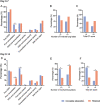Organizing pneumonia of COVID-19: Time-dependent evolution and outcome in CT findings
- PMID: 33175876
- PMCID: PMC7657520
- DOI: 10.1371/journal.pone.0240347
Organizing pneumonia of COVID-19: Time-dependent evolution and outcome in CT findings
Abstract
Background: As a pandemic, a most-common pattern resembled organizing pneumonia (OP) has been identified by CT findings in novel coronavirus disease (COVID-19). We aimed to delineate the evolution of CT findings and outcome in OP of COVID-19.
Materials and methods: 106 COVID-19 patients with OP based on CT findings were retrospectively included and categorized into non-severe (mild/common) and severe (severe/critical) groups. CT features including lobar distribution, presence of ground glass opacities (GGO), consolidation, linear opacities and total severity CT score were evaluated at three time intervals from symptom-onset to CT scan (day 0-7, day 8-14, day > 14). Discharge or adverse outcome (admission to ICU or death), and pulmonary sequelae (complete absorption or lesion residuals) on CT after discharge were analyzed based on the CT features at different time interval.
Results: 79 (74.5%) patients were non-severe and 103 (97.2%) were discharged at median day 25 (range, day 8-50) after symptom-onset. Of 67 patients with revisit CT at 2-4 weeks after discharge, 20 (29.9%) had complete absorption of lesions at median day 38 (range, day 30-53) after symptom-onset. Significant differences between complete absorption and residuals groups were found in percentages of consolidation (1.5% vs. 13.8%, P = 0.010), number of involved lobe > 3 (40.0% vs. 72.5%, P = 0.030), CT score > 4 (20.0% vs. 65.0%, P = 0.010) at day 8-14.
Conclusion: Most OP cases had good prognosis. Approximately one-third of cases had complete absorption of lesions during 1-2 months after symptom-onset while those with increased frequency of consolidation, number of involved lobe > 3, and CT score > 4 at week 2 after symptom-onset may indicate lesion residuals on CT.
Conflict of interest statement
The authors have declared that no competing interests exist.
Figures





References
-
- WHO. Coronavirus disease 2019. 2020. https://www.who.int/emergencies/diseases/novel-coronavirus-2019/situatio.... Accessed April 29, 2020.
MeSH terms
Substances
LinkOut - more resources
Full Text Sources
Medical
Research Materials
Miscellaneous

